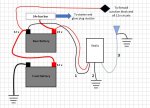You're welcome!
Just for fun, let's take a look at that idea of hooking a radio (or any other accessory) to the rear battery. It seems reasonable, and I think it's helpful for people to understand
why it won't work.
First, the idea:

Looks straightforward enough. That's a 12v battery back there, so if we connect the radio ground to the battery negative terminal, and the radio power lead to the battery positive terminal, we should have 12v to the radio. Yep, that's correct. Makes sense. Good to go, right? Not so fast.....
Let's introduce a new term: "wrt". That means, "with respect to". Any time we specify a voltage, we have to know the reference point. Voltage is just a difference in electrical potential between two points. We can't have a voltage unless we have two points to measure. At Point A, we have XX volts with respect to Point B. Always two points.
When we're talking about automotive stuff, it's just
assumed that the reference point is the chassis, which we call, "ground". So we toss around 12v this, and 12v that, and never mention it's "12v with respect to ground". And that's usually just fine. Nothing wrong with that. But, because people assume it, sometimes what's
really going on is not understood well.
But when we get into this 24v business, and start monkeying with the rear battery, we'd better understand the concept. In the illustration above, the radio has 12v
with respect to the negative terminal of the rear battery. That's fine,
but that's not at all the same as 12v wrt ground. That radio, at its power lead, has
24v wrt ground!
Now, that would be just fine and dandy
if those were the only two connections to that radio. Really! The radio would never know the difference, and it would be happy as a clam. No problem at all.
But those are
not the only two connections to that radio. The chassis of the radio is normally mounted in such a way that it is electrically connected to the chassis of the vehicle. I have indicated that on my drawing below as a wire going to ground (#2 on the diagram below). That "wire" isn't really there - I just put it there to provide a
symbol of a real electrical connection that
does (usually) exist. Screws go into the body of the radio, attaching it to a mount of some kind, which is in turn screwed into some sheet metal which is electrically connected to the vehicle chassis (ground). So that radio mount is (effectively) the #2 wire.
Then you also have the antenna. That is typically mounted in a way that grounds it to the chassis of the vehicle, and it, in turn, is connected to the chassis of the radio. Again, I have shown this very real connection as a wire which doesn't actually exist (#3 on the diagram below).
So let's look at this:

Take a look at wire #1 there. That's the radio's ground wire, which connects the radio chassis to the negative terminal of the rear battery. Take a voltage reading at that point, and you'll see that it's at 12v wrt vehicle ground, right? Of course it is. It's also connected to the positive terminal of the front battery, with a pretty big cable.
Whoops. That wire #1 (+12v wrt ground) connects to the radio chassis,
which is also connected to the vehicle's chassis through #2 and #3!
That means there's a direct connection between +12v wrt vehicle ground and..... vehicle ground! You just connected the positive terminal of the front battery straight to ground through your radio!
The result of that?












